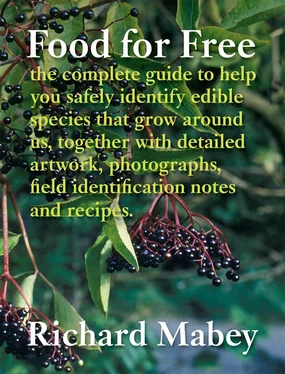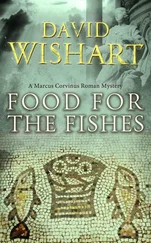To make hazelnut bread, grind a cupful of young nuts, and mix with the same amount of self-raising flour, half a cup of sugar and a little salt. Beat an egg with milk, and add it to the mixture, beating then kneading it until you have a stiff dough. Mould to a loaf shape, and bake in a medium oven for 50 minutes. Hazel leaves were used in the fifteenth century to make ‘noteye’, a highly spiced pork stew. The leaves were ground and mixed with ginger, saffron, sugar, salt and vinegar, before being added to minced pork.
Nut cutlet
50 g (2 oz) oil
50 g (2 oz) flour
500 ml (1 pint) stock
75 g (3 oz) breadcrumbs
50 g (2 oz) grated hazelnuts
Milk or beaten egg for glazing
Salt and pepper
• Mix the oil and flour in a saucepan. Add the stock and simmer for ten minutes, stirring all the time.
• Add the breadcrumbs and grated hazelnuts. Season.
• Cool the mixture and shape into cutlets.
• Dip the cutlets into an egg and milk mixture, coat with breadcrumbs and fry in oil until brown.
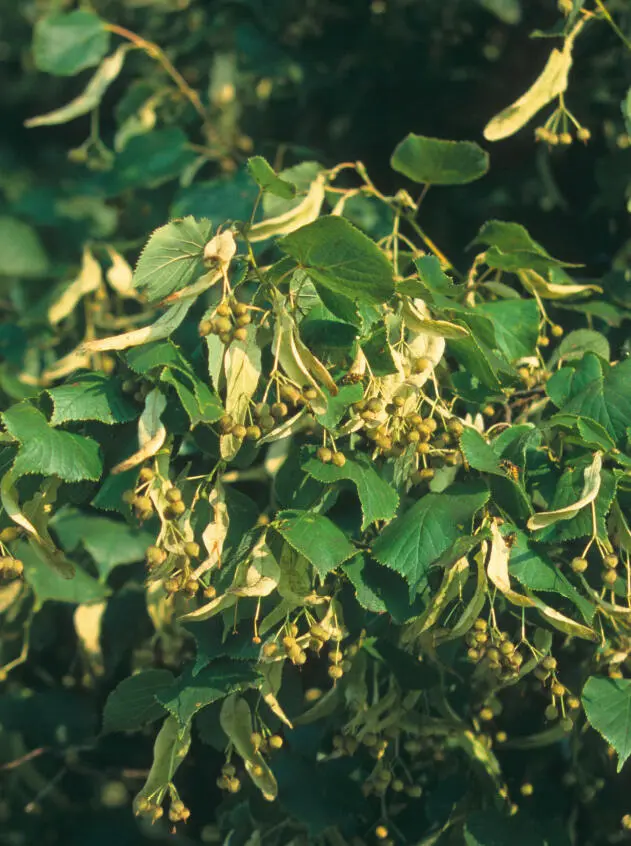
© David Hosking/FLPA
Lime Tilia europaea
Common in parks, by roadsides and in ornamental woods and copses. The lime is a tall tree, up to 45 m (150 ft) when it is allowed to grow naturally, with a smooth, dark brown trunk usually interrupted by bosses and side shoots. Flowers in July, a drooping cluster of heavily scented yellow blossoms. Leaves are large and heart-shaped, smooth above, paler below with a few tufts of fine white hairs.
The common lime is a cultivated hybrid between the two species of native wild lime, small-leaved (Tilia cordata) and large-leaved (T. platyphyllos), and it is now much commoner than both. It is one of the most beneficent of trees: its branches are a favourite site for mistletoe; its inner bark, bast, was used for making twine; its pale, close-grained timber is ideal for carving; its fragrant flowers make one of the best honeys. Limes are remarkable for the fact that they can, in bloom, be tracked down by sound. In high summer their flowers are often so laden with bees that they can be heard 50 m (160 ft) away. The leaves make a useful salad vegetable. When young they are thick, cooling, and very glutinous. Before they begin to roughen, they make a sandwich filling, between thin slices of new bread, with unsalted butter and just a sprinkling of lemon juice. Cut off the stalks and wash well, but otherwise put them between the bread as they come off the tree. Some aficionados enjoy them when they are sticky with the honeydew produced by aphid invasions in the summer. In late June and July the yellow flowers of mature lime trees have a delicious honey-like fragrance, and make one of the very best teas of all wild flowers. It is popular in France, where it is sold under the name of tilleul.
Tilleul
Gather the flowers whilst they are in full bloom, in June or early July, and lay them out on trays or sheets of paper in a warm, well-ventilated room to dry. After two or three weeks they should have turned brittle and will be ready for use. Make tea from them in the usual way, experimenting with strengths, and serve like China tea, without milk.
Sloe, Blackthorn Prunus spinosa
Widespread and abundant in woods and hedgerows throughout the British Isles, though thinning out in the north of Scotland. A stiff, dense shrub, up to 6 m (20 ft) high, with long thorns and oval leaves. The flowers are small and pure white and appear before the leaves. The fruit is a small, round, very dark blue berry covered when young with a paler bloom.
The sloe is one of the ancestors of cultivated plums. Crossed with the cherry plum (Prunus cerasifera), selected, crossed again, it eventually produced fruits as sweet and sumptuous as the Victoria plum. Yet the wild sloe is the tartest, most acid berry you will ever taste. Just one cautious bite into the green flesh will make the whole of the inside of your mouth creep. But a barrowload of sloe-stones was collected during the excavation of a Neolithic lake village at Glastonbury. Were they just used for dyeing? Or did our ancestors have hardier palates than us? For all its potent acidity, the sloe is very far from being a useless fruit. It makes a clear, sprightly jelly, and that most agreeable of liqueurs, sloe gin.
Sloe gin
The best time to pick sloes for this drink is immediately after the first frost, which makes the skins softer and more permeable. Sloe gin made at this time will, providentially, just be ready in time for Christmas. Pick about a pound of the marble-sized berries (you will probably need a glove as the spines are stiff and sharp). If they have not been through a frost, pierce the skin of each one with a skewer, to help the gin and the juices get together more easily. Mix the sloes with a quarter of their weight of sugar, and half fill the bottles with this mixture. Pour gin into the bottles until they are nearly full, and seal tightly. Store for at least two months, and shake occasionally to help dissolve and disperse the sugar. The result is a brilliant, deep pink liqueur, sour-sweet and refreshing to taste, and demonstrably potent. Don’t forget to eat the berries from the bottle, which will have quite lost their bitter edge, and soaked up a fair amount of the gin themselves. And try dipping the drunken sloes in molten chocolate first. As an alternative, try replacing the gin in the recipe above with brandy or aquavit.
© Nicholas and Sherry Lu Aldridge/FLPA
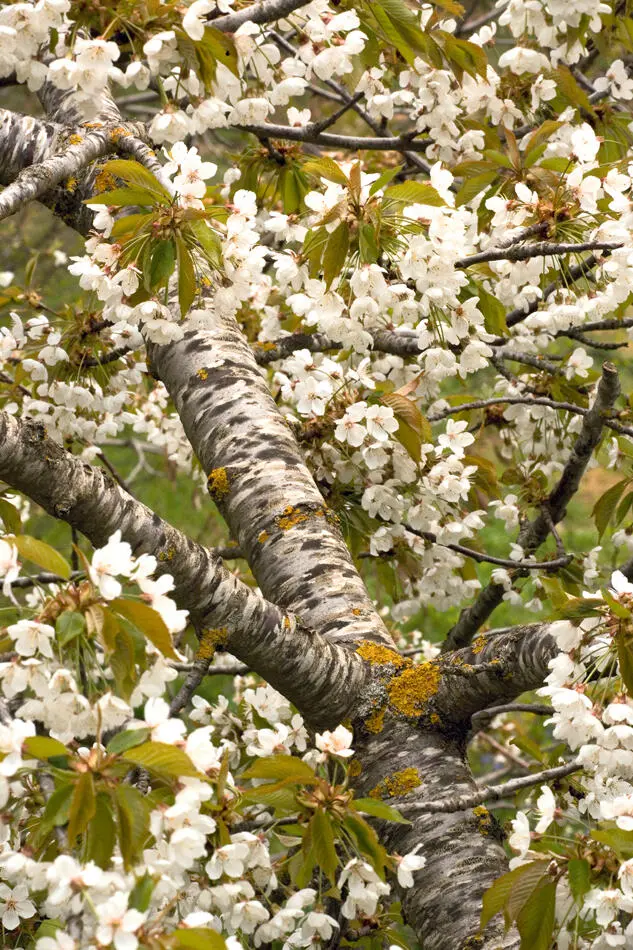
© Bob Gibbons/FLPA
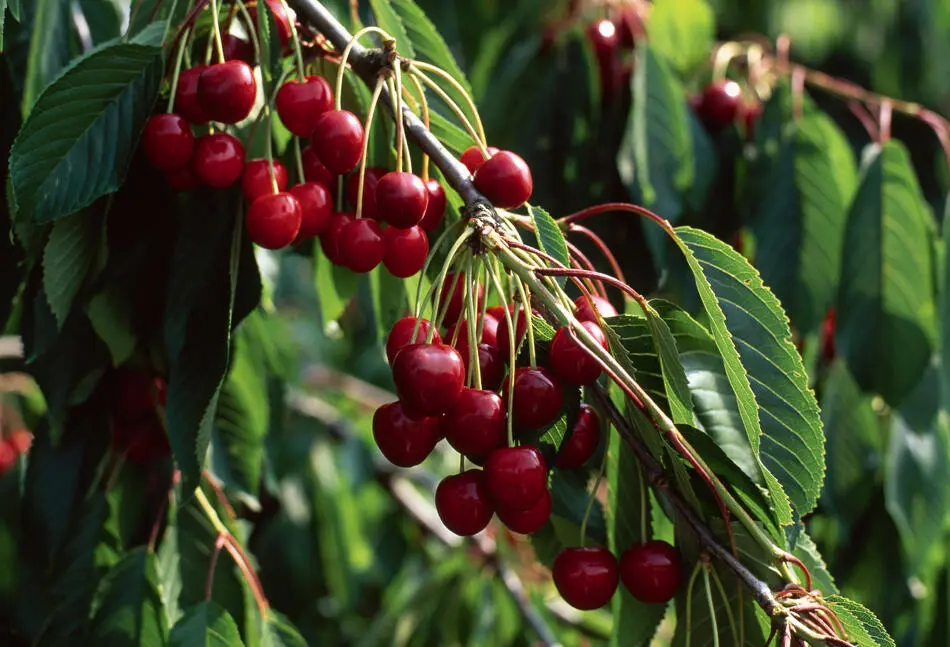
© A.N.T. Photo Library
Wild Cherry Prunus avium
Widespread and frequent in hedgerows and woods, especially beech. A lofty tree, up to 30 m (100 ft) high, with shining, reddish-brown bark and an abundance of five-petalled white flowers in the spring. Leaves are alter-nate, oval, sharply toothed. The fruit is like a small, dark or light red, cultivated cherry.
The wild cherry is a beautiful tree in the springtime, and again in autumn when the leaves turn red. The fruit can be either sweet or bitter. It used to be sold occasionally in London on the branch. These are the best fruits to use for cherry brandy. Put as many as you can find in a bottle with a couple of teaspoons of sugar, and top up with brandy. It will be ready after three or four months. Another wild cherry product is the sticky resin that exudes from the trunks, especially if they’re damaged in some way. This has been used by children and forestry workers as a kind of chewing gum. It has, like most gums, more texture than taste.

© John Eveson/FLPA
Bullace, Damsons and Wild Plums Prunus species

The true bullace, Prunus domestica ssp. insititia, may be a scarce native of old hedgerows, but the majority of wild plums found in the countryside are either seeded from garden trees or are reverted orchard specimens. Fruit blue-black, brownish, or green-yellow, and usually midway in size between a sloe and a cultivated damson.
Читать дальше
